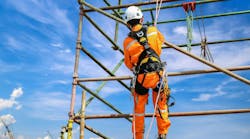Both water supply and sewage and waste disposal construction in the United States have just experienced two “break out” years, according to Heather Jones, a construction economist with Raleigh, N.C.-based research firm FMI. Indeed, FMI shows that after several years of slow growth, and even negative growth for water construction in 2004 (see Table), sewage and waste disposal put in place construction was up 14% in 2005 and 15% in 2006, while water supply put in place construction was up 12% in 2005 and 11% in 2006.
“According to the Natural Resource Defense Council, most cities rely on pipes constructed prior to World War I,” Jones says. “That's why we're having the boom. The aging infrastructure and the population really are the two big drivers.”
Another big driver for this market is the improvement in economic conditions. “Now, at least at the national level, we're almost at an all-time high in [tax] receipts. So they're having a little more funding available than usual,” she says.
FMI's sewage and waste disposal category includes dry waste and consists of plants, line and pump stations, and drains. The water supply category tracked by FMI consists of: filtration, treatment, supply, and softening plants; wells; culvert water transmission pipe lines, tunnels, and water lines; pump stations; reservoirs; and tanks and towers.
“There are 16,000 wastewater systems in the U.S., and since the Clean Water Act of 1972, the federal government has pumped $72 billion into the construction of publicly owned sewage treatment facilities,” Jones says.
Clearly, there is still much work to do. “Reports have shown that there are sections of the sewer system that are over 200 years old that are still in operation today,” Jones continues.
For aging infrastructure, retrofit construction requires either entirely new systems to be put in place or else the most dilapidated parts of the system replaced with new parts. Sewage and waste systems are certainly in need of some work, according to the EPA, which estimates that every year, there's enough untreated sewage that enters the environment in each county throughout the United States to fill both the Empire State Building and Madison Square Garden. But aging infrastructure isn't the only catalyst for construction growth in this sector.
Jones says that over the past two decades, the demand for water has grown dramatically due to a booming residential market, though she says non-residential is driving demand as well. This demand has led some southern and western states to place new restrictions on water use. “Reservoirs where we get the water supply are lower,” she says. “Even rain water is treated to turn into water supply.”
Unlike most construction industries, the government principally pays for water-related construction. The local agencies typically get state and federal funds for their water and wastewater infrastructure needs, but they also have to come up with money of their own, Jones says, often from owners/developers that are building new neighborhoods or shopping centers. But according to the EPA, Jones says, allotted government funds for water-related construction don't seem to be keeping pace with demand.
“There's the drinking water state revolving fund, and the current federal administration has allotted over $841 million for 2007, and it's estimated that only covers 10% of the need,” Jones says. “According to the EPA, they said it will cost $277 billion over the next 20 years to repair or replace the aging pipes and related equipment. And ‘The Clean Water and Drinking Water Infrastructure Gap Analysis’ by the EPA estimates a potential 20-year funding gap for drinking water ranging from $45 billion to $263 billion.”
Despite the recent upturn in construction for this industry, Norcross, Ga.-based Reed Construction Data showed that new project starts for water and sewer construction in October were off by 4.6% year to date versus 2005, due to some project starts delayed to obtain more funds or scale the project back to fit with available funds.
New York-based McGraw Hill Construction predicts that federal support for clean water state revolving funds will be reduced in 2007, forcing states and localities to pick up the slack in order to meet EPA wastewater quality standards. As a result, McGraw Hill predicts sewer construction to drop 3% in 2007.
Areas with major population surges, such as California, Chicago, and Atlanta, are experiencing the most water-related construction. But over the next few years as the housing market cools, so will construction in this segment, growing by single digits yearly after 2007 through 2010, according to FMI. But this is also partly because high growth rates are not sustainable for long periods of time based on funding levels, Jones says.
“We don't expect a decrease in total [water-related construction] dollars, but we don't expect huge increases either,” Jones says. “It will be kind of status quo, and that will be because of population. That alone is going to put new stress on the system.”


